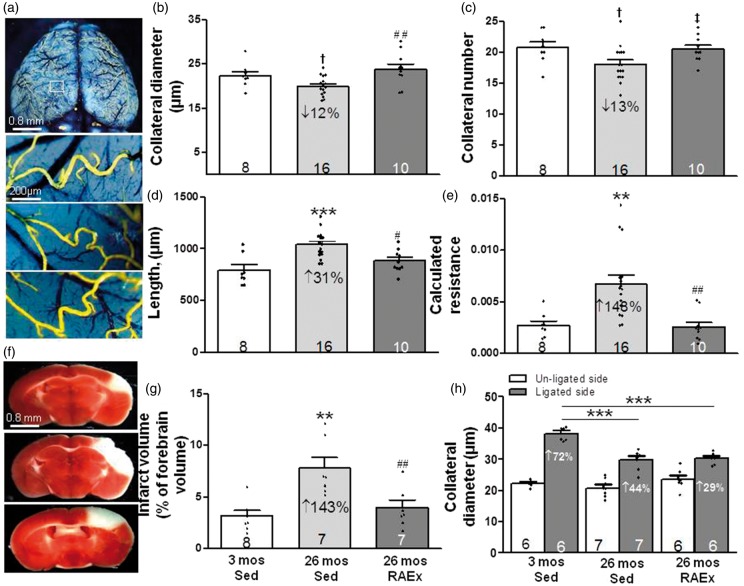Figure 1.
Regular aerobic exercise prevents age-induced rarefaction of pial collaterals and associated increase in infarct volume. (a, f) Representative images of pial collaterals (after maximal dilation, formaldehyde fixation and filling with MicrofilR) and infarctions (2,3,5-triphenyltetrazolium chloride staining measured 72 h after permanent MCA occlusion) in 3-month-old sedentary (Sed, top), 26-month-old Sed (middle) and 26-month-old regular aerobic exercised mice (RAEx, bottom). (b–g) Exercise prevented age-induced collateral rarefaction (decline in number and diameter of MCA-to-ACA collaterals), increase in collateral length, increase in calculated resistance of the MCA-to-ACA collateral network [collateral length/(collateral number x diameter4)], and increase in infarct volume. (h) Exercise did not prevent the decrease in collateral remodeling with aging (measured three days after MCA occlusion). For all figures unless stated otherwise in the legend: Data are mean ± SEM for the n-sizes given in the figures (number of animals), with significance defined as p < 0.05 determined by ANOVA, Bonferroni protected t-, Student’s t- and X2 tests; each three-bar group (3-month-old sedentary (Sed), 26-month-old Sed, 26-month-old RAEx or eNOSTG) was tested, if significant by ANOVA, for three post hoc comparisons using Bonferroni-protected two-tailed t-tests, where *,**,*** denotes p < 0.05, < 0.01, < 0.001 versus 3-month-old Sed and where #, ##, ### denotes p < 0.05, < 0.01, < 0.001 versus 26 month-old Sed mice. If a comparison was not p < 0.05 by the above test, the two-tailed Bonferroni test was constrained to comparison of two groups/bars among the following groups: 3-month-old Sed, 26-month-old Sed, 26-month-old RAEx or 26-month-old eNOSTG, where †, ††, ††† denotes p < 0.025, < 0.005, < 0.0005 versus 3-month-old Sed and where ‡, ‡‡, ‡‡‡ denotes p < 0.025, < 0.005, < 0.0005 versus 26-month-old Sed. Constraining was justified since the above two-bar comparisons were pre-specified in the experimental design based on previous results; 14–18,20–22,30–33 nevertheless, the p values were halved, as above, to maintain protection against a type-II error in the 2-group comparison. ANOVAs for panels B-D,E,G,H are p < 0.05– < 0.001.

